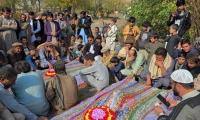The rise of social media has reshaped everything we knew about communication, but in doing so, has also allowed dangerous and misleading content to proliferate. This seems to be a global problem but in countries like Pakistan, where digital literacy is alarmingly low, this breeding ground for rumours and disinformation becomes more disturbing, often stoked by groups aiming to manipulate public sentiment for political purposes. A stark example of this played out recently in Lahore, when viral posts on social media ignited violent protests, subsequently spilling over to Rawalpindi and Islamabad. The spark? A now-debunked claim of rape. While some conscientious journalists did investigate and report that there was little to suggest the rumours were true, we now have a joint fact-finding mission led by the Human Rights Commission of Pakistan (HRCP) and the AGHS Legal Aid Cell that has found no credible evidence to support the claim. Nonetheless, the damage was done – anger and fear spread like wildfire, leaving behind a trail of unrest and loss. We must add here that rape is not at all something that should be taken lightly, which is why as journalists it is difficult to even imagine that anyone would use such claims cynically. Even if the original intention behind the posts was to highlight harassment on campuses, all this only ends up undermining genuine cases.
It’s not just the creators of the disinformation who bear responsibility. The administrative response from the college where the false claim originated was equally flawed. Instead of addressing students’ legitimate concerns and assuring them that a thorough investigation was underway, the administration reportedly dismissed their fears, going so far as to berate students and threaten them with disciplinary action. Such an approach only serves to deepen the public’s distrust of authority figures and amplify frustration. This mismanagement and lack of sensitivity fueled the protests, ultimately transforming a situation that could have been handled with dialogue into one marked by public outrage and violence.
The dark role that social media played in this episode demands immediate attention from both the government and social media watchdogs. Authorities must join forces with organisations committed to combating fake news, employing every available tool to trace and shut down the origins of such disinformation. Those who deliberately spread chaos must face strict repercussions, while ongoing awareness campaigns should educate the public on identifying and avoiding fake news. Pakistan cannot afford the repeated social and economic cost of disinformation-induced unrest. It’s time for authorities, educational institutions, and civil society to work together in countering the toxic spread of false narratives. Without effective action, we risk a future where truth becomes irrelevant and chaos becomes the new norm.
Even on social media platforms, women journalists face indescribable abuse
KP govT unveils roadmap which highlights measures such as special security force, deweaponisation
Christians and other minority groups face discrimination when it comes to employment, housing, education and security
PTA’s rationale is to monitor VPN traffic to ‘address security concerns’, but in reality, this could lead to...
Deaths due to militant attacks have now soared well past 1000 mark
Dialogue between government and opposition is cornerstone of any functioning democracy







